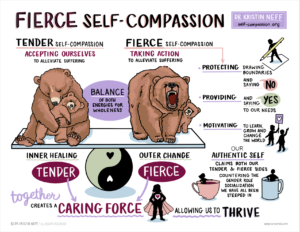In a previous blog, How Can I be Nicer to Myself?, I discussed one type of self-compassion, called tender self-compassion. When people think of self-compassion, this is often the type that comes to mind. However, there is another type of self-compassion: fierce self-compassion.
Fierce Self-Compassion versus Tender Self-Compassion: A Distinction
Tender self-compassion is meeting yourself with kindness and reminding yourself you are not alone during difficult times. Fierce self-compassion involves protecting yourself by setting boundaries, advocating for your needs, and motivating yourself for change by taking courageous action in challenging situations.
Both tender and fierce self-compassion are important for caring for yourself. According to Kristin Neff, pioneering founder of self-compassion research and author of the groundbreaking book Fierce Self-Compassion, “when both are present, it creates a caring force that can be used to transform ourselves and the world around us.”
Dr. Neff has used yin and yang as a metaphor for fierce and tender self-compassion. She explains that yin represents the gentleness that is found in tender self-compassion and yang represents the firm, goal-oriented energy of fierce self-compassion.
The below picture helps me to imagine these two types of self-compassion working together. Tender self-compassion is like a momma bear soothing its baby, while fierce self-compassion is a momma bear using ferociousness to protect her child.

The difference, though, is that rather than providing comfort or protection to someone else, you are turning it inward.
Understanding Fierce Self-Compassion: Redefining Strength and Self-Care
Some people have a harder time sticking up for themselves than others. In particular, people who were socialized female may relate to feeling limited by the sorts of behaviors that gender roles demand us to internalize.
People may hold beliefs such as: “If I stand up for myself, I’ll be judged” or that “being assertive is mean or rude.” It is important to change these belief systems! These beliefs could keep you from taking fierce action to draw boundaries or stand up for yourself when it is important to do so, and not doing so can lead to burnout or harm.
An example of this is when someone asks you for a favor but you are unavailable. In the past, maybe you have engaged in people pleasing behavior, said yes, been stretched too thin, and felt burned out. By saying no, your voice is heard, you can get the self care you need, and you will have more authentic relationships. Additionally, by taking care of yourself, you will be able to continue to help others going forward.
Standing up for yourself can be a way to show yourself care. By beginning to be assertive with fierce compassion, people can feel empowered, protected, and begin to alleviate suffering in their lives.
Unmitigated communion scale:
This following rating scale can help determine if your tendency to care for others and yourself is in balance or not.
Instructions:
Please read each statement carefully before answering. For each item, think about whether you agree or disagree with the statement, thinking especially about how accurately it describes the way you relate to people close to you, friends, or family. Respond using a scale of 1 (strongly disagree), 2 (slightly disagree), 3 (neither agree nor disagree), 4 (slightly agree), or 5 (strongly agree).
- I place the needs of others above my own.
- I find myself getting overly involved in other people’s problems.
- For me to be happy, I need other people to be happy.
- I worry about how other people get along without me when I am not there.
- I have great difficulty getting to sleep at night when other people are upset.
- It is impossible for me to satisfy my own needs when they interfere with the needs of others.
- I can’t say no when someone asks me for help.
- Even when exhausted, I will always help other people.
- I often worry about other people’s problems.
After you’ve made your responses, calculate the total score and divide by 9 to get a mean score. Scores above 3 indicate that your caring is somewhat lopsided.
If you have a tendency to put the needs of others above your own, you may benefit from practicing fierce self-compassion.
Mastering Fierce Self-Compassion: Practical Tips and Strategies
 To witness the incredible power of fierce self-compassion, you’ll use the same components of tender self-compassion: mindfulness, kindness, and common humanity. Mindfulness shows up when we are aware of our needs and when something needs to change. We show kindness to ourselves by protecting ourselves through boundary setting. Common humanity helps us recognize we are not alone; that others have gone through what we are going through now.
To witness the incredible power of fierce self-compassion, you’ll use the same components of tender self-compassion: mindfulness, kindness, and common humanity. Mindfulness shows up when we are aware of our needs and when something needs to change. We show kindness to ourselves by protecting ourselves through boundary setting. Common humanity helps us recognize we are not alone; that others have gone through what we are going through now.
- Below is a practice exercise from Kristin Neff’s book Fierce Self-Compassion that combines both fierce and tender self-compassion:
- Sit comfortably but make sure your back is straight. Put both hands on your solar plexus (stomach area) or some other place that helps you feel strong and supported.
- Start to notice your breathing. Don’t change it or control it, just breathe naturally.
- Your mind will wander. When it does, bring your attention back to this exercise without judgment.
- Now start to focus on your in-breath. Specifically, feeling each inhalation.
- As you breathe in, imagine that you are breathing in fierce yang energy. Feel the power rising from the base of your spine.
- If you like, you can imagine the fierce energy as a bright white light flowing through your entire body.
- Do this for about two minutes, or longer if desired.
- Take a big breath in and hold it for about five seconds, then release.
- Now put your hands on your heart or some other soothing place.
- Begin to focus on your out-breath, feeling yourself relax with each exhalation.
- As you exhale, let go and let be.
- With each out-breath imagine that tender yin compassion is being released-loving, connected presence. Let it nurture you, heal you.
- If you like, you can imagine this energy as a soft golden light flowing through you.
- Do this for two minutes or more.
- Once again, take a big breath in and hold it for about five seconds, then release.
- Now bring yin and yang together, putting one hand on your heart and the other on your solar plexus or some other place that feels comfortable.
- As you breathe in, imagine that you are breathing in fierceness, as you breathe out, imagine that you are breathing out tenderness.
- Allow these two energies to flow freely in your body, merging and integrating.
- Let the inward and outward flow be as natural as the movement of the ocean, waves going in, waves going out.
- If it feels right you can focus more on the in-breath or the out-breath, depending on what you need most in the moment.
- Do this for about five minutes, or longer if you like.
- When you’re ready, gently open your eyes.
You can find more fierce self-compassion exercises here.
Conclusion
Fierce and tender mindful self-compassion together help us to be whole in our human imperfection and both are necessary for overall well being. You may have been taught that it is bad or mean to be assertive, but that is not the case. Fierce self-compassion can be used as a protective tool and is a beautiful act of self care, and it can also be a spiritual practice that helps us connect to our true nature. Using fierce self-compassion can help us see challenging situations in a more positive light as a learning opportunity and the chance to practice standing up for ourselves in the way we deserve.
These concepts may be very new to you and that’s okay! It may feel very foreign to be self-compassionate in a fierce or tender way. Incorporating a self-compassion practice into one’s daily life takes time, but it is a beautiful goal. Shoot for progress, not perfection.
If you need extra help to practice either type of self-compassion, consider scheduling an appointment with a therapist to address these areas.
When is a time that you showed fierce self-compassion?
Blog written by Sentier therapist, Andrea Schroeder, MS, LPC, LPCC
Sources:
Fierce Self Compassion by Kristen Neff, Ph.D.
https://self-compassion.org/fierce-self-compassion/











